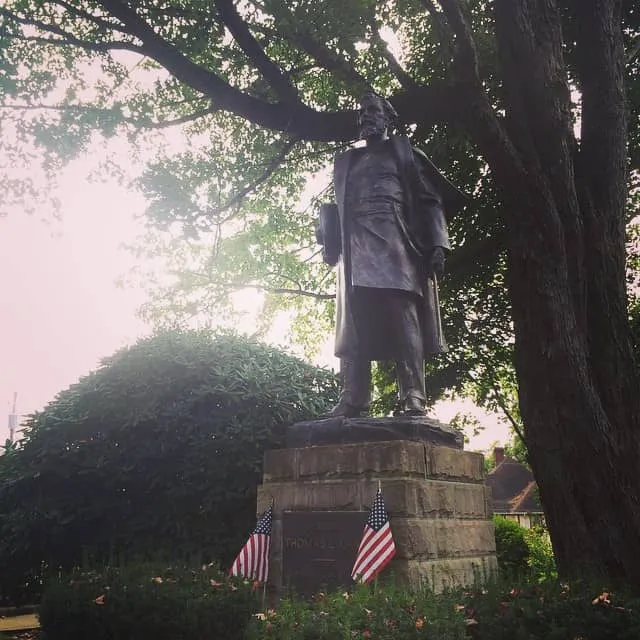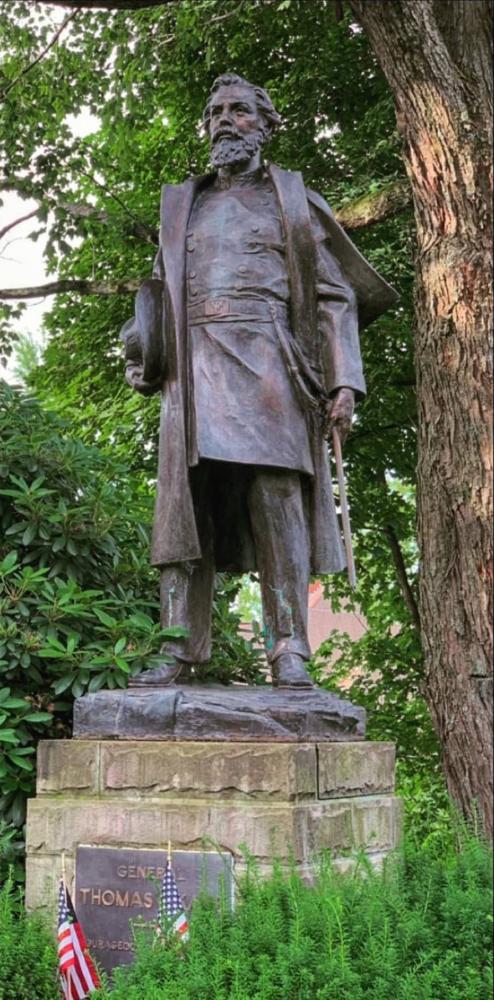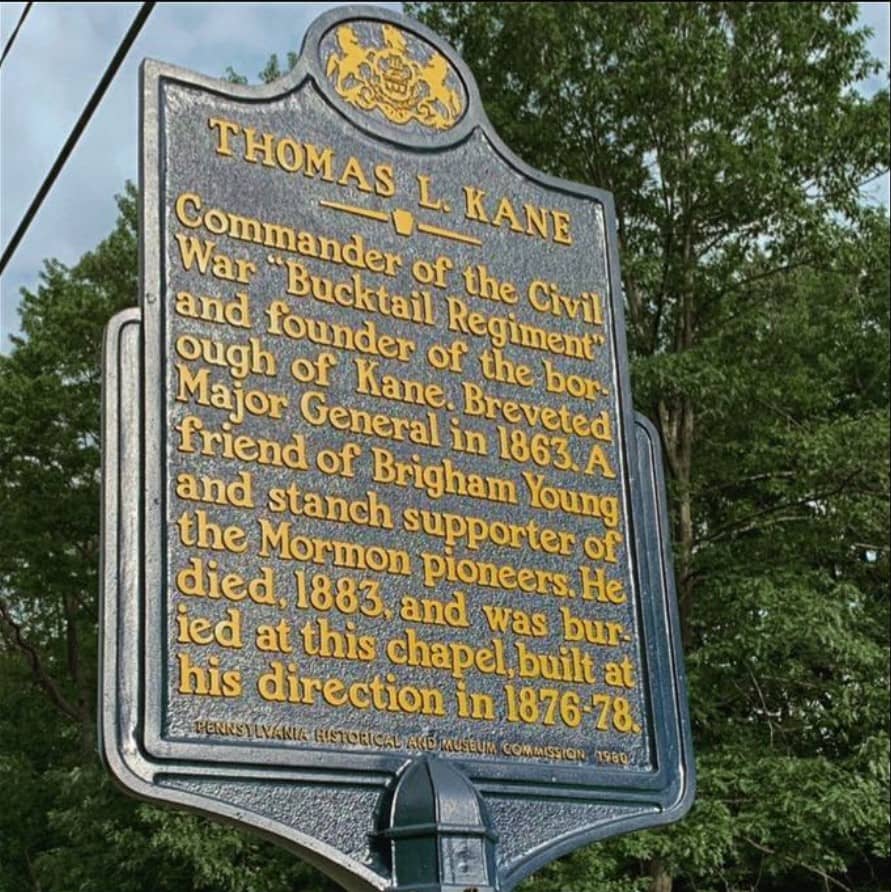Born February 27, 1822, in Philadelphia, Thomas L. Kane was a descendant of several of the oldest pre-Revolutionary War families in the northern colonies. He received a formal education in Paris, France. Still, he returned to Philadelphia and accepted a position with the federal government under his father, John K. Kane, a United States District Court judge. He also studied law in his native city.
The cause of the anti-slavery movement attracted his attention, and Thomas Kane resigned his commissionership, not solely because his position would have demanded his obedience to the Fugitive Slave Law, but because he became a director of the "Underground Railroad," which enabled many of the runaway black slaves to escape to Canada and freedom. In the late 1840s, Thomas Kane persuaded President James K. Polk and the War Department to accept the enlistment of the 500-member Mormon Battalion, which aided in establishing American sovereignty in Southern California. He also assisted the Mormons by helping their church obtain federal help in the immigration of Mormon pioneers to the West. Through his generous efforts, he became a close friend and confidant of Brigham Young, then the controversial leader of the religious sect.
Thomas L. Kane made his initial visit to the general area of Elk County as an agent for the McKean and Elk Land Improvement Company. With a survey party of scouts, prospectors, and woodsmen, Kane, acting in a secondary role as city director of the Sunbury and Erie Railroad, gathered extensive information on the region's mineral and timber resources. It wasn't until two years after his first exploration in the Elk County area that Kane returned to Northwestern Pennsylvania.
An unofficial adviser to early Mormon church officials and a close friend of Brigham Young's, Kane resigned his clerkship with the District Court at Philadelphia to embark on a special mission that averted a possible Mormon rebellion in the West. Following their settlement at Salt Lake City, Utah, the Mormons elected Brigham Young as their church leader and named him governor of the territory.When James Buchanan assumed the presidency of the United States in 1857, he appointed Alfred Cummings to replace Young as the territorial governor. Cummings, accompanied by a detachment of 2,500 troops, approached the Utah capital, and the Mormons threatened war. To avoid an open rebellion and wholesale bloodshed, Brigham Young entreated Thomas Kane (whose political influence was augmented by his powerful father's) to intervene. Thomas Kane took up the matter and settled the differences between the Mormons, who were wrongly accused of inhabiting the territory in hostile opposition, and the federal forces. After much consultation with the White House and at his own expense, Kane reconciled the opposing factions in two months. For his successful intervention, he earned the title of "peacemaker." A heroic-sized statue of Kane occupies the central spot of prominence in the rotunda of the Utah State Capitol. A county in Utah bears his name in honor.
Thomas L. Kane finally returned to the wilderness of McKean County in 1858, encumbered by governmental positions and duties. By 1860, construction began on his house, but this project was abandoned when he volunteered his services to the Union forces during the outbreak of the Civil War. He organized and commanded Northwestern Pennsylvania's famed "Bucktail Regiment."
Thrice-wounded and held prisoner for two months, Kanewas was commissioned Brigadier-General in September of 1862. In recognition of his loyalty to the Union cause, he was named Major-General in 1863, when he resigned from active duty because of ill health. At the age of 41, and now a semi-invalid, General Kane once again journeyed to the sparsely inhabited Allegheny wilds in 1863 to found the town that bears his name today. Construction of his house, known for generations following as the "Old Homestead" (destroyed by fire ten years after the general's demise), resumed while the general diligently planned the layout of his settlement, which officially began bearing his name (through the United States Post Office's designation) in 1864.General Thomas L. Kane originally planned his settlement as a "Prohibition Borough," his idea of a 'model town' where the sale of liquor was forbidden by law. The early townsmen passed the original act of incorporation but never received the governor's signature. (Presumably it was lost en route from Kane to Harrisburg.) However, his strict regulations concerning the sale of liquor were never strictly adhered to, mainly because there was no legal document supporting General Kane's prohibitionist beliefs. Many of the sites for schools, churches, parks, highways, and right-of-ways for railroad lines were provided by General Kane, both as an individual promoter and as an agent for the land improvement company.
His local patriotism, legislative influence, and engineering skill established several important state roads. Regarded as one of the most powerful men in the promotion of rail lines in Northwestern Pennsylvania, he designated the routes of the Philadelphia and Erie Railroad, the Pittsburgh and Western Railroad, the Ridgway and Clearfield Railroad, and the New York, Lake Erie, and Western Coal Railroad. He was an organizer of the New York, Lake Erie, and Western Coal Railroad and, while serving as its president, directed in 1882 the construction of what was formany years to follow the largest railroad bridge in the world, the 2,053 feet long viaduct which spanned the 301 feet deep Kinzua Creek Valley, not far from Kane.
In addition to his hearty promotion of Kane and surrounding McKean County, General Kane was actively involved in politics. In 1880, he represented his congressional district at the Chicago Republican Convention. He served as the Republican state party leader and actively campaigned for President Ulysses S. Grant, who visited his ardent supporter in Kane. His political doctrines were liberal and unorthodox; he supported women's suffrage and the higher education of women.Five years after completing the Kane Chapel, whose work he supervised (and allegedly assisted in laying the heavy cut stones), General Thomas L. Kane died in Philadelphia on December 26, 1883. By his request, he was buried by his family between the two front stairways leading to the chapel, behind a simple iron fence. He was interred before the chapel despite some opposition by members of the Presbyterian congregation who thought he was too much of a Mormon to be a good Christian. Besides his grave, little exists memorializing the general in the town he founded.


